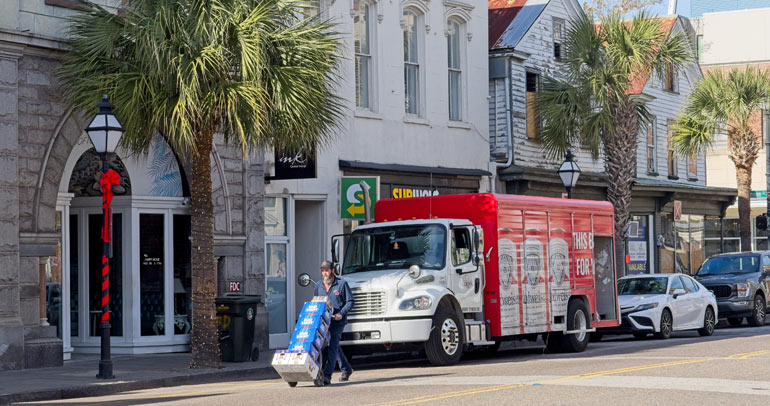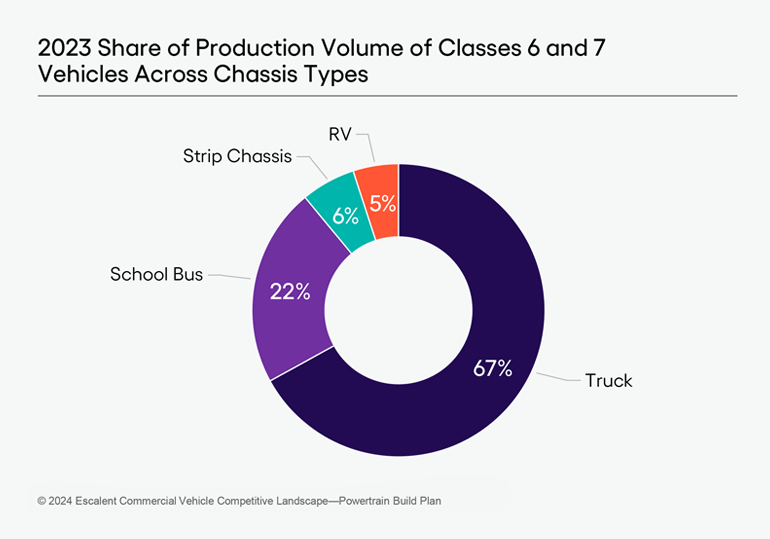
Drive through any busy school zone or down a busy highway and you’re sure to spot a class 6 or 7 commercial vehicle. From dump trucks and beverage trucks to school buses and recreational vehicles (RVs), these vehicles make up a significant portion of regional and school transportation in the United States and, in most cases, they have one aim: to get the job done.
Purely work vehicles, with the exception of RVs, classes 6 and 7 vehicles comprise almost half of the classes 4 through 7 North American medium-duty commercial vehicle market. The rise in electrification, telematics, and rentals and leasing are some of the major trends affecting this market.
If you’re an original equipment manufacturer (OEM), body company or supplier, this miniblog series covering trends and opportunities in the space is for you. In part 1, you’ll discover where the classes 6 and 7 commercial vehicles market is today. You’ll also learn about common use cases, top manufacturers, OEM and upfitter collaborations, and market outlooks for Conventional and Low Cab Forward (LCF) trucks.
In part 2, you’ll read more about School Buses, Strip Chassis and RVs, as well as gain strategic recommendations for success in this segment.
Where We Are Now With Classes 6 and 7 Commercial Vehicles
Similar to vehicles in classes 4 and 5, vehicles in classes 6 and 7 are used exclusively for commercial purposes, with gross vehicle weight rating (GVWR) capacities ranging from 19,501 to 33,000 pounds. However, unlike classes 4 and 5, which offer relatively standard vehicles, those in classes 6 and 7 provide a variety of customization options to help businesses maximize productivity.
Fuel: More than 80% of classes 6 and 7 vehicles run on diesel, according to our Commercial Vehicle Competitive Landscape—Powertrain Build Plan. This number is expected to decline to fewer than 50% by 2035, primarily due to substantial growth in electrification, especially in the School Bus subsegment.
Volume: More class 6 vehicles are produced than class 7, primarily due to driver license requirements and associated costs. Weighing 26,000 pounds or less, class 6 vehicles can be driven without a commercial driver’s license (CDL) for most applications, which allows fleet managers to hire drivers without a CDL at a lower cost. Vehicles weighing at least 26,001 pounds are classified as class 7 and require a CDL to operate, increasing expenses.
Subsegment production: The highest share of 2023 production volume belongs to the Trucks subsegment at 67%. School Buses are next at 22%, followed by Strip Chassis vehicles and RVs.

The Current State of Classes 6 and 7 Trucks
As we rise through vehicle classes, we see less of an influence from the Big 3 manufacturers— Ford, GM and Stellantis/Ram. In the classes 6 and 7 market, Freightliner leads with approximately one-third of the market share, followed by International and then Ford. Freightliner’s M2, International’s MV line and Ford Super Duty are the best-selling nameplates in this segment.

Classes 6 and 7 Truck Cab Configurations
Vehicles offered in classes 6 and 7 are versatile and customizable. For example, although Ford’s F-650/F-750 and the LCF Trucks from Isuzu and PACCAR have limited customization options, they serve both weight classes. On the other hand, Freightliner M2, International MV, Peterbilt Models 536/537 and Kenworth T280/T380 offer a range of customization in terms of transmissions, axles, chassis components and powertrains.
Other models such as Ford F-600 and GM Silverado 6500 HD are extensions to their corresponding class 5 models (Ford F-550 and GM Silverado 5500 HD, respectively), with GVWR extensions up to 23,500 pounds and the ability to upfit with a variety of body types.
Classes 6 and 7 Truck Powertrains and Drivetrains
While diesel trucks, followed by gasoline, currently dominate the classes 6 and 7 market, increasing electrification will shift the market in the coming years. By 2030, electric and hybrid trucks are projected to account for 14% and 19% of this market, respectively.
When it comes to drivetrains, most classes 6 and 7 trucks are 4×2 rear-wheel drive, with fewer than 5% equipped with 4×4 configurations. Due to the higher cost of 4×4 in this market, it’s only used in niche applications that require off-road capabilities. In contrast, more than 47% of trucks in classes 4 and 5 are 4×4.
LCF vs. Conventional Trucks
Conventional Trucks offer a traditional riding position as well as easy ingress and egress, while LCF Trucks offer better visibility and maneuverability in city traffic. LCF Trucks also allow for a longer body and increased carrying capacity. Popular LCF Truck models in this segment are Isuzu F-Series, Kenworth K270/K370 and Peterbilt Model 220. Although most businesses use regular cabs, industries such as utilities and construction use crew and extended cabs.
Unlike classes 4 and 5 vehicles, classes 6 and 7 vehicles offer more customization options for upfitted body types. Some of the most used body types and their applications include:
- Box Trucks: Commonly up to 30 feet long, used by delivery companies and for raw material transport
- Refrigerated Trucks: Equipped with refrigeration units for transporting perishable and frozen goods
- Dump Trucks: Designed for bulk material transport, primarily in construction and landscaping
- Tanker Trucks: Used for transporting liquids and gases, including water, gasoline and chemicals
- Rollback Tow Trucks: Feature rollback bodies for towing one vehicle and transporting another
- Flatbed Trucks: Allow for easy loading and unloading of raw materials
- Crane Trucks: Equipped with cranes for lifting at construction sites and utility work
- Beverage Trucks: Designed with specialized compartments to deliver beverages, often insulated for temperature control
- Special-Purpose Body Trucks: Includes vehicles for road maintenance, street sweeping and line marking
There are strong collaborations between OEMs and upfitters to facilitate a more cohesive body-building process, particularly for made-to-order products, enhancing efficiency and responsiveness.
Collaborations Between OEMs and Upfitters
Because specifications can be complex—especially in class 7 vehicles—it’s important that dealers and outfitters talk to each other about the requirements needed for each vehicle. In classes 6 and 7, we see collaborations between OEMs and truck equipment manufacturers (TEMs), as well as OEMs and upfitters.
OEMs such as Freightliner, International, PACCAR and Mack work with TEMs that are often located close to their manufacturing plants. Modifications can include adding bodies and customizing chassis specifications to meet customer requirements. Some examples include complex alterations such as 4×4 conversions, dual steering systems and stand-up driving.
One TEM that has partnered with multiple classes 6 and 7 vehicle manufacturers is Fontaine Truck Equipment. These types of collaborations allow vehicles to remain in the factory delivery system for nationwide distribution of work-ready trucks. In addition, manufacturers partner with body builders such as Morgan, Knapheide, Wabash and Utilimaster to create specialized truck bodies.
What Lies Ahead for Classes 6 and 7 Trucks
OEMs are offering advanced features and the latest technologies in their medium-duty trucks, including:
- Safety Features: OEMs are incorporating safety suites, dash cams, additional cameras around the trucks and advanced driver assistance systems as standard features.
- Telematics: OEMs are increasingly offering their own telematics services, such as Ford Pro, GM OnStar and Freightliner’s Detroit Connect, to enhance fleet routing, streamline vehicle management and reduce operational costs. Telematics adoption is expected to rise in the coming years.
- Lightweighting: To offset the added weight of electric vehicles and avoid the 12% federal excise tax on vehicles weighing over 33,000 pounds, OEMs are focusing on lightweighting batteries and components.
- Vehicle-as-a-Service (VaaS): Many class 6 users, often non-experts, prefer leasing trucks from third-party operators. These users are likely to choose fleet/truck-as-a-service providers that manage vehicle, charging, battery, insurance and other costs on a subscription basis. For instance, Mack Trucks offers a VaaS program on its medium-duty electric truck that bundles the costs of charging infrastructure, installation and maintenance into a monthly payment.
The State of School Buses, Strip Chassis and RVs, Plus More Insights and Recommendations
Now that you’re familiar with the overall landscape of classes 6 and 7 commercial vehicles, visit part 2 of this miniblog series to find out more about:
- The current state of and outlook for School Buses, Strip Chassis and RVs
- Which subsegments will see the most growth in electrification
- Strategic recommendations you can apply in your own business to strengthen your vehicle offerings and market position
Contact us by completing the form below to discover more about how our commercial vehicle and fleet experts can help you more accurately and effectively plan your products and strategies through a more complete view of current and future commercial vehicle supply, demand, inventory and sales data.
Want to learn more? Let’s connect.










